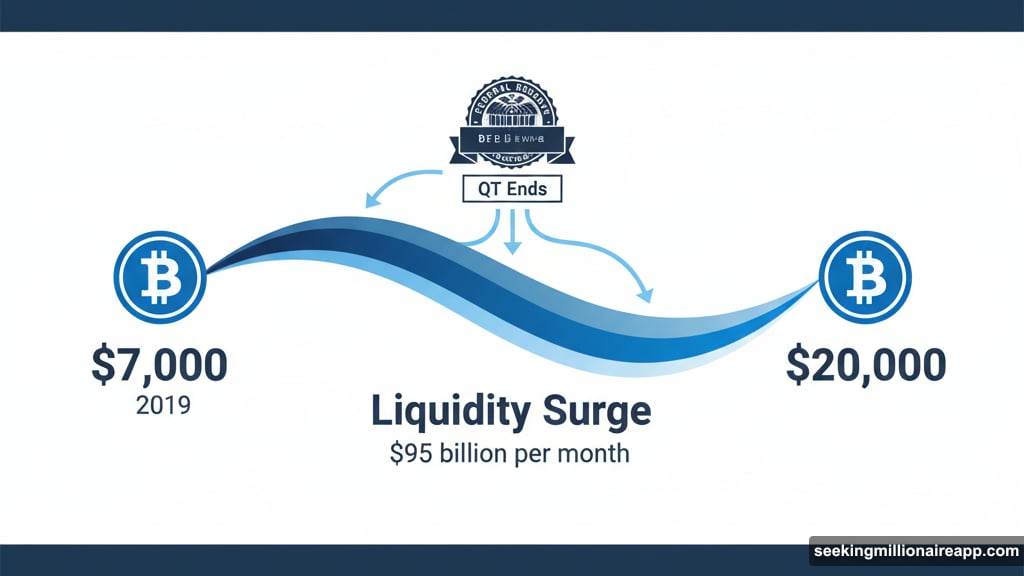The Federal Reserve sits on the brink of a major policy shift. Prediction markets are screaming near certainty for rate cuts. Meanwhile, whispers grow louder about ending quantitative tightening altogether.
Crypto traders remember what happened last time. When the Fed opened liquidity floodgates in 2019, Bitcoin tripled over several months. Now similar conditions appear to be forming. So the question becomes: Are we about to see history repeat itself?
Rate Cut Is Already Priced In
The numbers tell a clear story. Polymarket shows 98% probability the Fed cuts rates by 25 basis points at this week’s meeting. That’s not speculation anymore. It’s essentially guaranteed.
CME FedWatch Tool data confirms this outlook. Their models put the likelihood at 99.9%. Yet the real excitement isn’t about rate cuts themselves. Those are expected. Instead, traders focus on what might come next.
The Federal Reserve’s quantitative tightening program has been shrinking its balance sheet for months. But that process could be nearing its end. If true, the implications reach far beyond simple interest rate adjustments.
Quantitative Tightening May Be Finished
Research from the Federal Reserve Bank of Cleveland highlights a critical issue. The central bank needs to maintain ample reserves. When those reserves dropped too low in September 2019, markets seized up badly.
The Fed had to intervene quickly back then. They injected massive liquidity to stabilize funding markets. Plus, that intervention coincided with Bitcoin’s dramatic rise from around $7,000 to over $20,000 within months.
Fast forward to today. Market participants see similar warning signs. Reserves may be approaching levels that trigger another policy reversal. So ending quantitative tightening becomes less a question of “if” and more about “when.”
Ending QT would halt the Fed’s balance sheet reduction. Instead of letting securities mature without replacement, the Fed would maintain or even grow its holdings. That means more dollars flowing through the financial system.
Crypto Markets Connect the Dots
Traders aren’t waiting for official announcements. They’re positioning for what could become a major liquidity surge. The potential catalyst? Up to $95 billion per month in additional liquidity if QT ends completely.
Popular crypto analyst Lark Davis laid out the bullish case bluntly. Rate cuts tomorrow seem certain. Rumors of QT ending are spreading. Meanwhile, US-China trade negotiations could add another positive catalyst. Combined, these factors point toward what he calls “a mega bullish November for crypto.”
VirtualBacon drew explicit parallels to 2019. Back then, ending QT unleashed a liquidity wave that powered Bitcoin’s massive rally. The setup today looks remarkably similar. If the Fed pivots again, digital assets could benefit substantially.
But there’s a crucial difference. Today’s crypto market is far more mature than 2019. Institutional adoption has grown. Regulatory frameworks exist. Exchange-traded funds hold billions in Bitcoin. So while history might rhyme, the outcome won’t be identical.
Liquidity Doesn’t Guarantee Rallies
Rising liquidity typically supports risk assets. More dollars chasing investments tends to push prices higher. However, several factors complicate this simple narrative.
Inflation remains a concern despite moderating from peak levels. The Fed still prioritizes price stability. If inflation resurges, rate cuts could reverse quickly. That would undermine the bullish thesis.
Economic growth matters too. Liquidity helps mainly when investors feel confident about prospects. But if recession fears grow, even abundant liquidity might not prevent market declines. Cash could sit on the sidelines instead of flowing into crypto.
Regulation adds another layer of uncertainty. The US government continues developing clearer crypto rules. Some regulatory moves support the industry. Others create headwinds. Plus, election outcomes in 2024 could shift policy dramatically.
Adoption trends remain critical. Bitcoin and other digital assets need continued use case expansion. If mainstream adoption stalls, liquidity alone won’t sustain prices. Real demand must match the available capital.
Global Dollar Dynamics Play a Role

The Federal Reserve’s balance sheet affects liquidity worldwide, not just domestically. Dollar availability influences funding conditions across international markets. Ending QT would ease those conditions globally.
Crypto markets operate 24/7 across borders. So changes in dollar liquidity ripple through digital asset prices quickly. Many stablecoins tie directly to the dollar. Plus, most crypto trading pairs still denominate in USD.
Emerging markets particularly benefit from easier dollar funding. When the Fed tightens, dollar scarcity can stress developing economies. Conversely, ending QT could spark capital flows into higher-risk assets, including crypto.
China’s economic situation adds complexity. Trade negotiations between the US and China could reduce tensions. But structural issues remain. How those play out affects global risk appetite and crypto demand from Asian markets.
November Could Deliver or Disappoint
The next few weeks will test whether 2019 patterns repeat. If the Fed signals an end to quantitative tightening, liquidity expectations will shift immediately. Market reactions could be swift and substantial.
Bitcoin currently trades below recent highs. A confirmed policy pivot might provide the catalyst for breaking through resistance levels. Altcoins typically follow Bitcoin with amplified moves. So the entire digital asset space could benefit.
However, disappointment is possible too. The Fed might maintain QT longer than expected. Rate cuts could come with hawkish language about fighting inflation. Macro conditions could deteriorate despite easier policy. Any of these would dampen the bullish case.
Position sizing matters here. While the setup looks promising, certainty doesn’t exist. Smart traders manage risk appropriately rather than betting everything on one outcome. The potential for a liquidity-driven rally is real. But so are the risks.
History shows the Fed’s policy shifts powerfully affect crypto markets. When liquidity flows freely, Bitcoin tends to thrive. When the Fed tightens, digital assets usually suffer. We may be approaching another major inflection point.
The comparison to 2019 isn’t perfect. Markets have evolved. Conditions differ. Yet the fundamental relationship between liquidity and risk assets remains. If the Fed opens the taps again, crypto could benefit substantially.
Whether November becomes legendary or just another month depends on factors still unfolding. Watch the Fed’s language carefully. Monitor balance sheet data. Pay attention to global economic signals. The pieces are moving into place for something significant.
